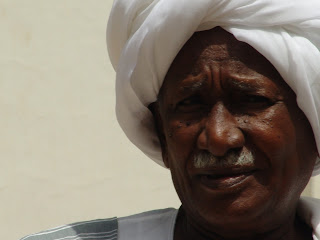 |
| male and female models in Khartoum June show |
Last week a court in Khartoum fined seven male Sudanese models for wearing make-up under the public order act. The woman who applied the make-up was also fined. The group had participated in a fashion show organised in a Khartoum club in June. The models as well as many of the on-lookers were arrested in a police raid immediately at the end of the show. Fashion shows are not foreign to Khartoum even under the rule of the National Congress Party (NCP). In the elite prosperity of oil the city had started to develop its touch of glamour stretching Islamic codes and breaching them all the same. The president’s wives for instance are the standard honour guests of female fashion shows in Khartoum’s hotels where Sudanese beauties present the latest tob trends. Men also caught up, and beauty parlours dedicated to male customers and run by males are a flourishing business in the capital. In general, the government policy of segregating the sexes never really worked out, and where it did it generated subversive cultures beyond the immediate reach of the authorities.
The novelty of June’s fashion show was that it featured male models, an innovation the public order act does not actually account for apart from a general clause concerning ‘indecency’. Notably, the judge chose the mildest of sentences at his disposal. He could have equally ordered the flogging or the imprisonment of the accused. According to a BBC report the defence lawyer had argued that men frequently had to wear make up to appear on television, I add NCP officials included.
Under the same law 19 men were convicted of wearing women’s clothes and make-up last August, and consequently flogged 30 lashes each. The police claimed they were caught dancing in a womanly fashion. In principle, the ‘indecency’ incriminated in both cases is ‘effeminate’ behaviour, what under the Islamic codex applied in North Sudan falls under the broad category of ‘men imitating women’. The public order law and its enforcers, the public order police, have in the past years become the target of loud criticism in Khartoum. Accused of blackmailing women into sexual favours and exhorting bribes from an endless supply of victims the public order police suffers a serious deficiency in moral legitimacy even by its own proclaimed standards. Just a few days ago the Sudanese internet community was shocked by footage of a young woman being publicly whipped in a police station in Omdurman. In the narrative of Sudan’s shari’a, hudood punishments, i.e. shari’a sentences against crimes of murder, extra-marital sex, philandery, and theft, should be publically implemented before an audience of Muslim flock in order to achieve awe and deter others from doing the same. Knowing that the public morale does not condone the humiliation of mothers, daughters and sisters before such a crowd the police usually resort to flogging bnat al-balad, largely middle-class women of riverain extraction, behind the walls of detention cells. In response to the public outcry the police department issued an apologetic statement promising a high level investigation into the incident headed by the deputy police chief. Probably the policemen who featured in the footage, one at least attempting to hide his face in giggles, will face the wrath of police bureaucracy eager to regain its own ‘decency’.
The regular liberal response was a call to ‘false’ arms, human rights and so on. Since its declaration in 1983 shari’a has effectively been the disciplining tool of Khartoum’s rulers targeting in essence the urban under-class, a biopolitical instrument of painfully intimate impact, as much as it has been the liberation cry of a wide NCP rural constituency. Criticism against the implementation of shari’a from a human rights perspective only, I suspect, fails to comprehend these two significant aspects of its durability and appeal.




No comments:
Post a Comment